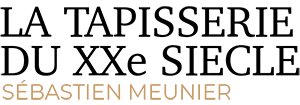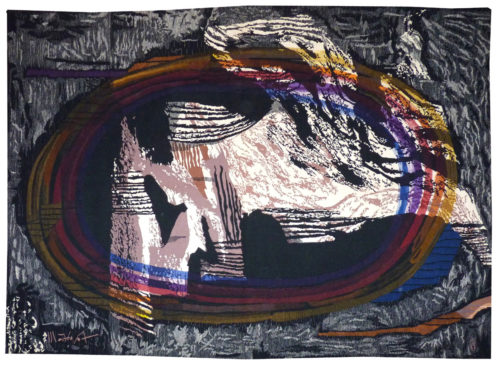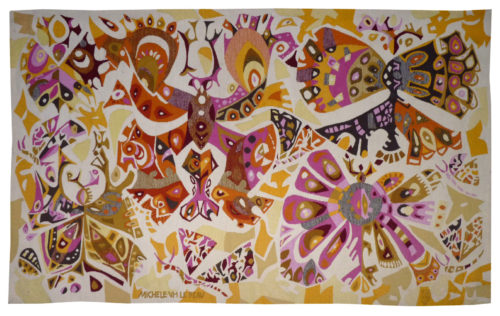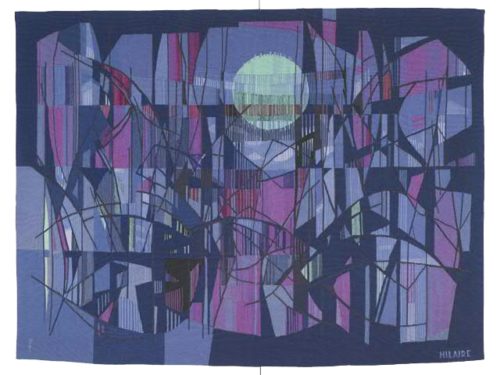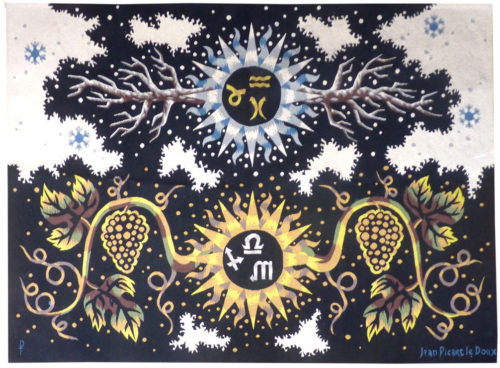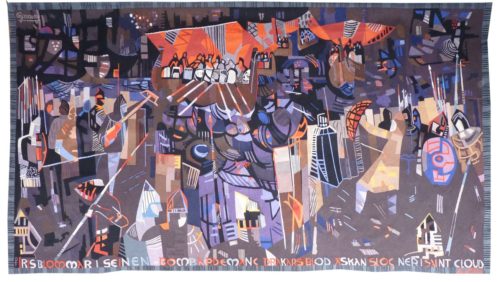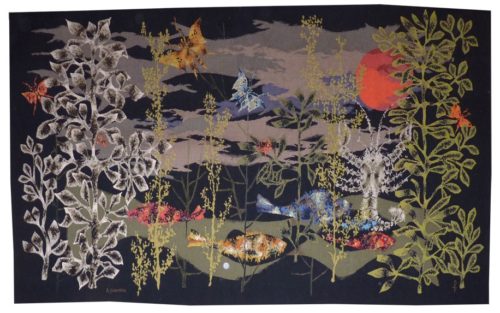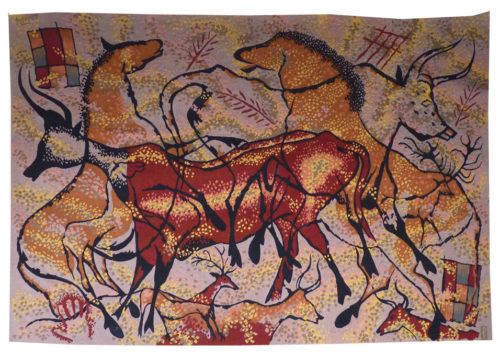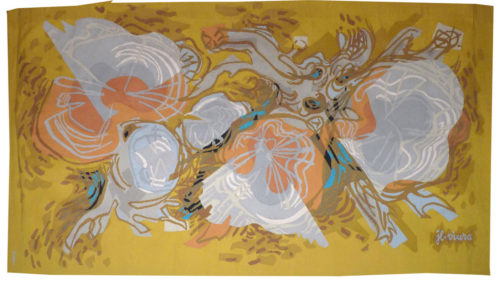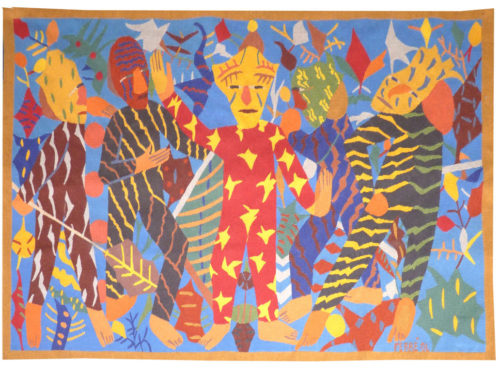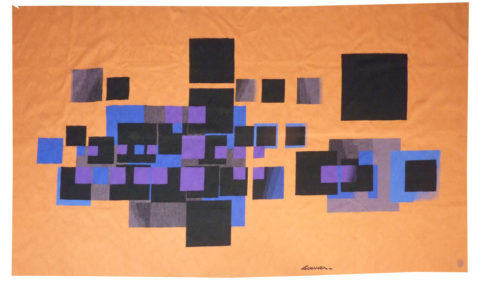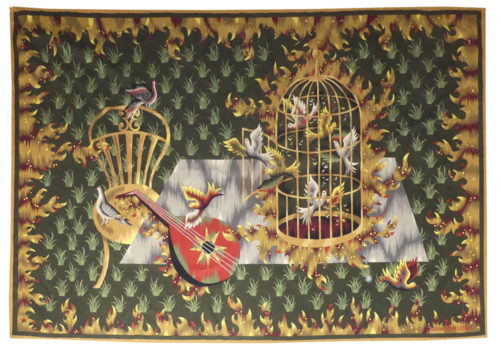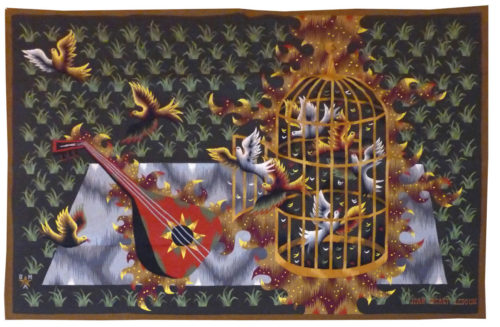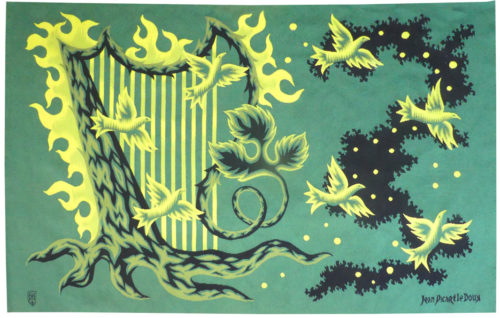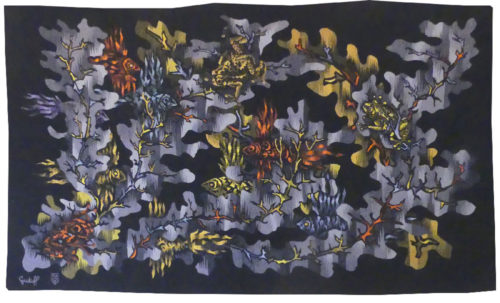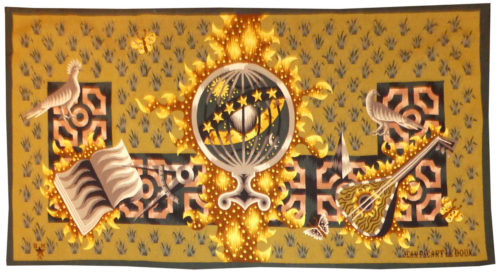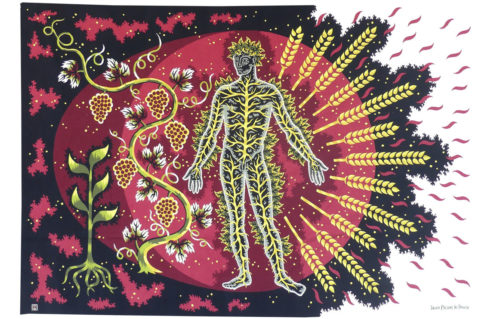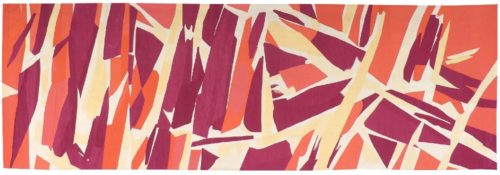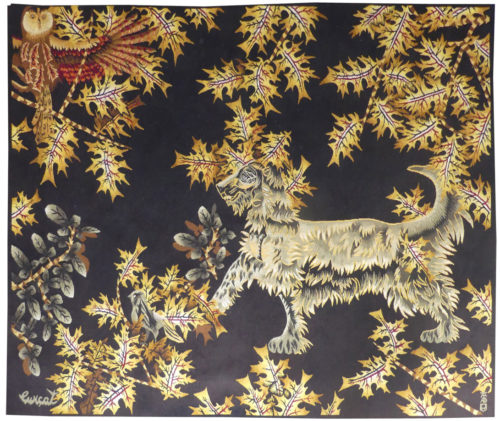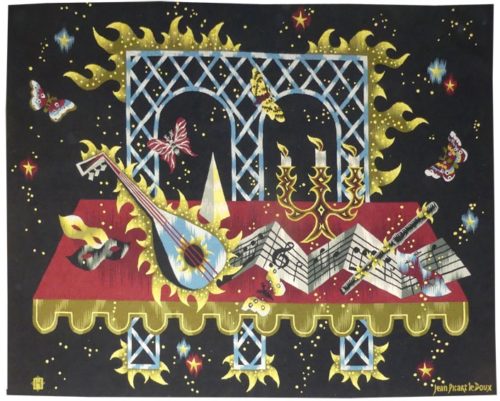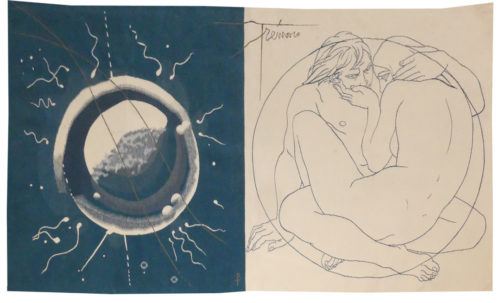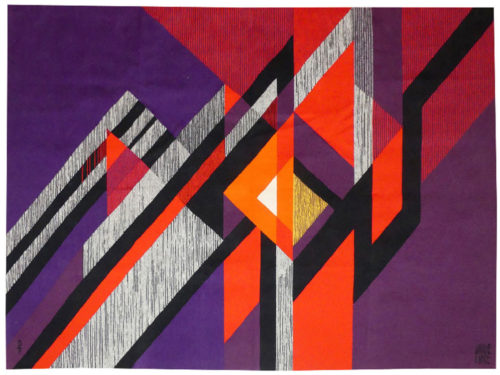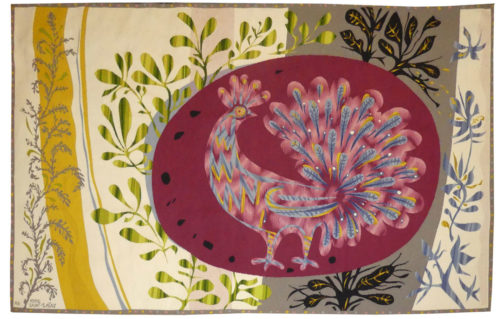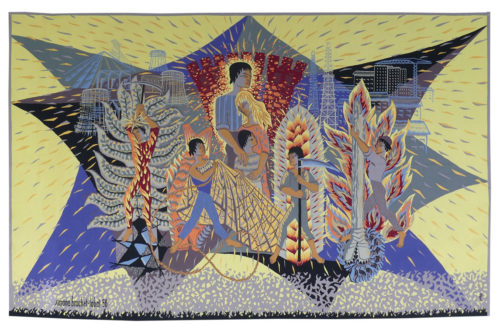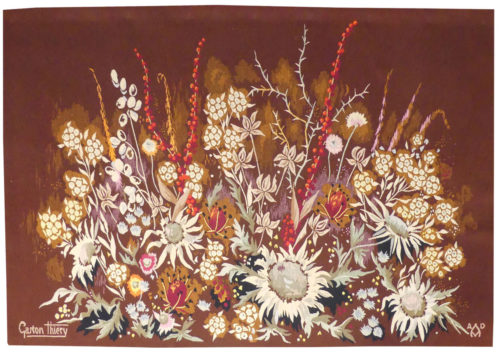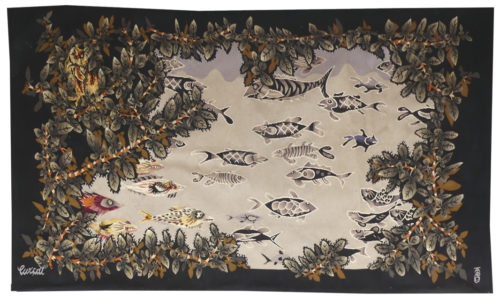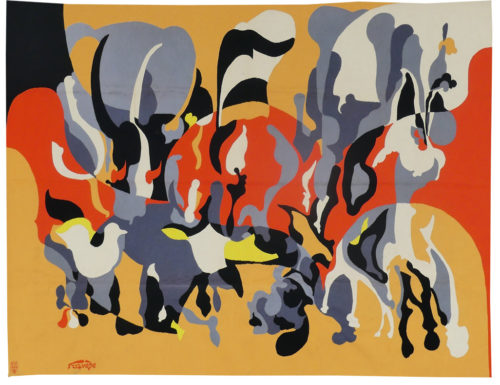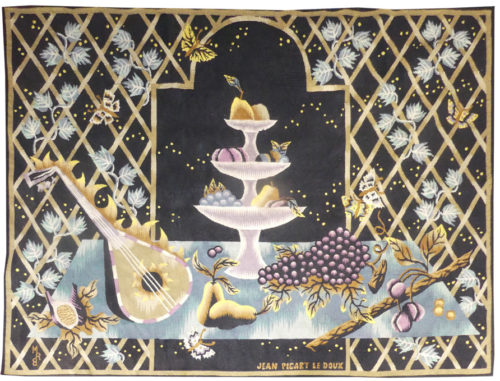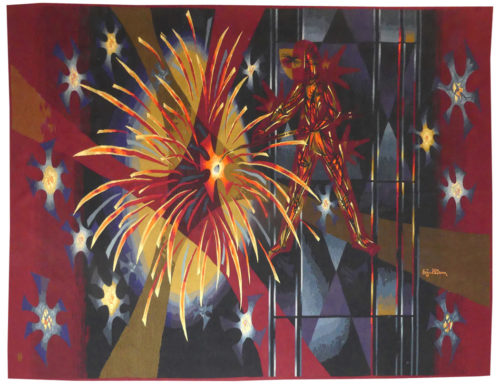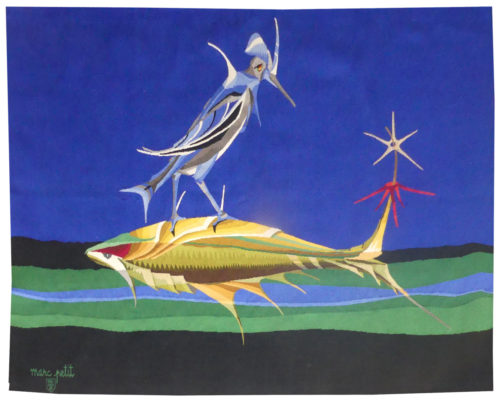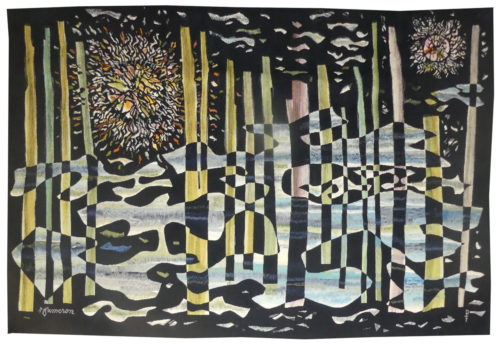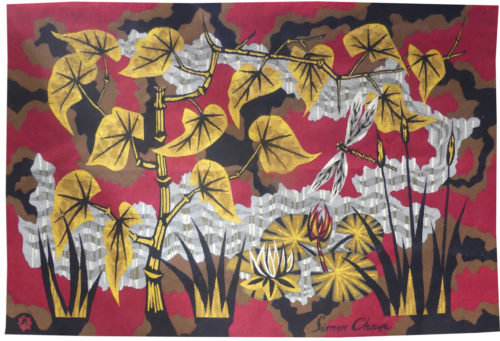-
Le Chalut (the trawler)
Aubusson tapestry woven by the Berthaut workshop. Complete with certificate of origin signed by the artist. 1952. Jean Picart le Doux is one of the foremost figures in the renaissance of the art of tapestry. His earliest contributions to the field date back to 1943 when he designed cartoons for the passenger ship “la Marseillaise”. A close associate of Lurçat, whose theories he would adopt (limited palette, numbered cartoons...), he was a founding member of the A.P.C.T. (Association des Peintres-cartonniers de Tapisserie), and soon after, a teacher at the Ecole Nationale Supérieure des Arts Décoratifs. The state gave him several commissions most of them at the Aubusson workshop, and some at the Gobelins : the most spectacular of these being for the University of Caen, the Theatre in Le Mans, the passenger ship France or the Prefecture of the Creuse département ... In as much as Picart le Doux’s aesthetic is close to that of Lurçat, so also is his insipiration and his subject matter, although in a register which is more decorative than symbolic, where he brings together heavenly bodies (the sun, the moon, the stars...), the elements, nature (wheat, vines, fish, birds...), man, literary quotation ... « One of the best-known of Picart le Doux’s tapestries : it is highly organised and the generous curves of the trawl net underline the choice of a large and simple graphic.” Is how Maurice Bruzeau describes this tapestry (n° 37 in his book) in the commentary he devotes to it. “The trawler” is typical of the marine themes which are omnipresent in this artist’s work, particularly at this period : “Dieu Marin (marine god), “La Sirène” (the mermaid), “le Dauphin” (the dolphin), “Fruits de mer” (shellfish), “Etoiles de mer” (starfish), in a range of muted colours revolving around kaki and silver grey. Here the treatment of the theme is more documentary (apart from the presence of a trident) : the subject is fishing, as it appears to Picart le Doux. Bibliography : Léon Moussinac, Jean Picart le Doux, Editions Cercle d’art,1964 (ill. Pl.10) Marthe Belle-Jouffray, Jean Picart le Doux, Publications filmées d’art et d’histoire, 1966, ill. n°4 Exhibition catalogue, Hommage à Jean Picart le Doux, Centre artistique et littéraire de Rochechouart, 1968 (ill.) Maurice Bruzeau, Jean Picart le Doux, Murs du soleil, Editions Cercle d’art 1972 Exhibition catalogue Jean Picart le Doux, Paris, Musée de la Poste, 1980 (ill.) Exhibition Catalogue Picart le Doux, château d'Olonne, 1992 (ill.) -
Remous (swell)
Aubusson tapestry woven in the Tabard workshop. Circa 1960. Matégot, originally a decorator, then creator of artefacts and furniture (an activity he abandoned in 1959) met François Tabard in 1945 and gave him his first cartoons, first of all figurative then rapidly of abstract design in the 1950’s. He became a member of the A.P.C.T. (Association des Peintres Cartonniers de Tapisserie) in 1949, participated in many international exhibitions (Matégot, like Lurçat before him, was an untiring advocate of the art of tapestry) fulfilled numerous public commissions, sometimes of monumental proportions (“Rouen” 85m2 for the Préfecture of the Seine Maritime département, and also tapestries for Orly Airport, for the Maison de la Radio, for the IMF...) and designed no fewer than 629 cartoons up until the 1970’s. In 1990 the Matégot foundation for contemporary tapestry was inaugurated in Bethesda, U.S.A. Matégot is an artist, like Wogensky, Tourlière or Prassinos, who turns wool textiles resolutely towards the abstract: at first lyrical, geometric in the 70’s, exploiting various technical aspects of the loom : colour graduations, shading, irregularities... Remous can be seen as representative of Matégot’s production around 1960 : lyrical, playing with transparency, using all the technical expertise of the weavers (colour shading and grading…) Its evocative title is a reminder of the artist’s interest for aquatic subjects (cf “Régates”) treated in an abstract-metaphorical way. Bibliography : Exhibition Cat. Les tapisseries de Mathieu Matégot, galerie La Demeure, 1962 (ill.) Exhibition catalogue, Matégot, Angers, Musée Jean Lurçat et de la Tapisserie Contemporaine, 1990-1991 -
Papillons de cocagne (ideal butterflies)
Aubusson tapestry, woven in the Picaud workshop. Complete with certificate of origin signed by the artist. Circa 1970. Michèle Van Hout le Beau designed numerous cartoons in the 1960’s and 70’s, working in collaboration with several workshops in Aubusson and receiving some state commissions (she participated along with Soulages, Lagrange, Alechinsky and others in the decoration of the transatlantic Boeing 707’s for Air France). Her style often involves the use of strident colours (very evocative of the 1970’s) from which emerge foliage, stylised human or animal figures. This cartoon, with its acidic colours is particularly characteristic of the artist’s style ; here we can also observe, on a theme abundantly developed by Lurçat, the different way in which the butterflies are evoked : the subject is here a pretext for highly coloured, geometrical evocations approaching abstraction. -
Nymphes et chasseurs (Nymphs and hunters)
Aubusson tapestry woven in the Pinton workshop for the Compagnie des Arts Français. 1941. The place occupied by André Planson in the history of tapestry-making is a direct result of the role that was alotted to him by Jacques Adnet in the synthesis of art and design advocated by the Compagnie des Arts Français of which he was the director. As early as 1941, Adnet approached several painters (Brianchon, Vera,... and Planson) to design tapestry cartoons in the context of furniture and interior design : “our intention was to demonstrate that contemporary tapestries have much to contribute to the integrated design of a room” (L. Chéronnet, Jacques Adnet, Art et Industrie 1948). The Compagnie des Arts Français organised throughout the 1940’s tapestry exhibitions on its premises. These ambitious decorative aspirations, which were important in encouraging the renewal of the art of the tapestry, remain however somewhat irrelevant to the preoccupations of Lurçat and his followers. The gracious and joyful attributes (compare with the contemporary creations of Lurçat or Gromaire) of the Compagnie are plainly evident in this cartoon dating from 1941 which brings right up to date the traditional tapestry themes of the hunting scene and bucolic pleasures in a voluntarily innovative style which is highly decorative. Although certain technical innovations typical of the Lurçat doctrine are already assimilated (limited palette, irregular stitch size) it is to be noted that this decorative intention is still influenced by techniques associated with painting (the use of perspective, and shading for flesh colours...) -
Camargue
Aubusson tapestry woven in the Pinton workshop. Complete with certificate of origin signed by the artist n° 4 of 6. 1963. With a taste for the large-scale, influenced by Untersteller at the Ecole des Beaux Arts, Hilaire undertook numerous mural paintings. In the same vein, beginning in 1949, along with a number of other artists stimulated by Lurçat, (he would join the latter at the A.P.C.T. Association des Peintres-Cartonniers de Tapisserie) he designed a number of cartoons some of which were woven at Beauvais or at Les Gobelins. His figurative cubist-influenced style (which sometimes approaches abstraction) is immediately recognisable in his tapestry cartoons : in this one, but also for example in the one designed for the Salon Fontainebleau for the ocean liner France, “Sous-bois” (undergrowth) (190 x 988 cm, Pinton frères, reproduced in Le paquebot France, Armelle Bouchet Mazas, Paris 2006p. 169) where shapes and colours are fragmented in a kaleidoscopic fashion. “Camargue” is reproduced in the “Tapisserie d’Aubusson” sample collection of the Guéret Chamber of Commerce and Industry published in the early 1980’s to illstrate the technical competence of the Aubusson workshops. Bibliography : Exhibition catalogue Hilaire, œuvre tissé, galerie Verrière, 1970 (ill.) Exhibition catalogue, du trait à la lumière, Musée Départemental Georges de la Tour at Vic-sur-Seille, 2010. -
Automne-Hiver (Autumn-Winter)
Aubusson tapestry woven by the Pinton workshop. Complete with certificate of origin n° 6 of 6. Circa 1975. Jean Picart le Doux is one of the foremost figures in the renaissance of the art of tapestry. His earliest contributions to the field date back to 1943 when he designed cartoons for the passenger ship “la Marseillaise”. A close associate of Lurçat, whose theories he would adopt (limited palette, numbered cartoons...), he was a founding member of the A.P.C.T. (Association des Peintres-cartonniers de Tapisserie), and soon after, a teacher at the Ecole Nationale Supérieure des Arts Décoratifs. The state gave him several commissions most of them at the Aubusson workshop, and some at the Gobelins : the most spectacular of these being for the University of Caen, the Theatre in Le Mans, the passenger ship France or the Prefecture of the Creuse département ... In as much as Picart le Doux’s aesthetic is close to that of Lurçat, so also is his insipiration and his subject matter, although in a register which is more decorative than symbolic, where he brings together heavenly bodies (the sun, the moon, the stars...), the elements, nature (wheat, vines, fish, birds...), man, literary quotation ... The theme of the seasons is a classic in the history of tapestry which was enthusiastically ressuscitated by the 20th century cartoon artists, of whom Lurçat was foremost (cf his Seasons wall hanging commissioned by the state in 1939). For Picart le Doux the inspiration is two-fold : Nature obviously but also Music ; “l’Hiver” (Winter) an allegorical treatment of the theme and one of the best-known works of this artist dates from 1950, but it is the “Hommage à Vivaldi” (Homage to Vivaldi) from 1963, with its 4 seasons represented in symbolic fashion by coloured suns, featuring symbols from the zodiac and fronds of vegetation that is the source of this cartoon where the motifs are reworked in a horizontal format. Bibliography : Maurice Bruzeau, Jean Picart le Doux, Murs de soleil, Editions Cercle d'art, 1972 -
Normands sur la Seine (Norsemen on the Seine)
Tapestry woven at Aubusson by the Pinton workshop. Signed certificate of origin n° 1. 1961. Lars Gynning is one of the numerous artists of various origins whose work would be woven in Aubusson during the years from the 50’s to the 70’s, at a period when tapestry imposed itself as an artistic medium. From a thematic point of view, this cartoon can be seen as a referrence, across the centuries, to Franco-Scandinavian relations seen through the prism of Viking incursions up the Seine estuary : an inevitable throw-back to the Bayeux tapestry. However, rather than a historic or diplomatic statement by Gynning, the cartoon in fact illustrates a saga by Evart Taube, the 20th century Swedish national poet (an extract from the text is woven at the bottom of the tapestry) ; added to the subject itself, the textile rendition of an epic saga is a gesture in the direction of the great mediaeval tapestry tradition, which was an inevitable model for many painter-cartoonists of the period. The aesthetic, which is resolutely contemporary and influenced by cubism, revitalises an ancient subject. -
Poissons de la lune (Moon fish)
Aubusson tapestry woven by the Pinton workshop. Complete with certificate of origin. Circa 1960. Fumeron designed his first cartoons (he would ultimately make over 500) in the 1940’s, in collaboration with the Pinton workshop, he was then commissioned on numerous occasions by the state before participating in the decoration of the ocean liner “France”. His work was figurative to begin with and influenced by Lurçat, then turned towards abstraction, before coming back to a style characterised by colourful figurative and realistic depictions from the 1980’s onwards. Beneath the red moon, fish, butterflies, a lobster all frolic in a dream-like composition typical of the artist : numerous examples of these motifs can be found for instance in “Avant l’homme” Before man, woven by the Gobelins (cf Exhibition Catalogue “le Mobilier National et les Manufactures Nationales des Gobelins et de Beauvais sous la IVe République”, Beauvais 1997) -
Hommage à l'abbé Breuil (a tribute to Father Breuil)
Aubusson tapestry woven by the Pinton workshop. Complete with certificate of origin. Circa 1955. Perrot began his career as a cartoon designer at the end of the war, making almost 500 cartoons including numerous commissions from the state, most of which were woven at Aubusson. His style which is particularly rich and decorative is eminently recognisable : a crowd of butterflies or birds, most often, stands out against a background of vegetation, reminiscent of the millefleurs tapestries (which would also inspire Dom Robert). Uncharacteristic cartoon whose inspiration lies in the cave paintings at Lascaux ; here it can be said that never has a tapestry merited quite so well the term « wall art ». Perrot’s input is, in the end, relatively modest : the use of saturated colours (particularly the mauve-pink background), the overlapping of the motifs (which are more spaced out in the cave itself), superficial laid over blotching,... If Perrot is an habitué of hommage-cartoons (Pergaud, Redouté, Audubon,...) this particular example is interesting because of the well-established proximity between the artist and the dedicatee, “the Pope of Prehistory”: here the hommage owes nothing to the artificiality of an official commission. Bibliography : Tapisseries, dessins, peintures, gravures de René Perrot, Dessein et Tolra, 1982 -
Soleils éteints (Extinct suns)
Aubusson tapestry woven in the Pinton workshop. Complete with certificate of origin signed by the artist, n°1/6. Circa 1970. Originally an engraver (Prix de Rome, intaglio technique in 1942), Jean-Louis Viard designed his first tapestry cartoons in the mid 1950’s. At first his work was figurative (he was collaborating at the time with Picart Le Doux), but then he evolved along the same lines as many other painter-cartoonists of the period (Matégot, Tourlière or Prassinos,...) towards abstraction. He produced scores of cartoons working up until the 2000’s, in parallel to his work as a painter and engraver, but throughout revealing a particular interest for the use of contrasting materials and textures in the tradition of the “Nouvelle Tapisserie” of which Pierre Daquin was one of the leading lights. The inspiration for his motifs, sometimes metaphysical (“Mémoires” Memories, “Destins” Destinies,…) is wide-reaching, from astronomical infinity « ténèbres solaires » solar darkness) to the microscopic (« Mutation végétale” Plant mutation) : a profuse and varied production, regularly exhibited at his home, in various public and private exhibition spaces and, most significantly, at the Salon Comparaison of which he was the curator for the Tapestry section. Origin : the artist’s workshop -
Destins (Destinies)
Aubusson tapestry woven in the Glaudin-Brivet workshop. Complete with certificate of origin signed by the artist, n°1/6. 1974. Originally an engraver (Prix de Rome, intaglio technique in 1942), Jean-Louis Viard designed his first tapestry cartoons in the mid 1950’s. At first his work was figurative (he was collaborating at the time with Picart Le Doux), but then he evolved along the same lines as many other painter-cartoonists of the period (Matégot, Tourlière or Prassinos,...) towards abstraction. He produced scores of cartoons working up until the 2000’s, in parallel to his work as a painter and engraver, but throughout revealing a particular interest for the use of contrasting materials and textures in the tradition of the “Nouvelle Tapisserie” of which Pierre Daquin was one of the leading lights. The inspiration for his motifs, sometimes metaphysical (“Mémoires” Memories, “Destins” Destinies,…) is wide-reaching, from astronomical infinity « ténèbres solaires » solar darkness) to the microscopic (« Mutation végétale” Plant mutation) : a profuse and varied production, regularly exhibited at his home, in various public and private exhibition spaces and, most significantly, at the Salon Comparaison of which he was the curator for the Tapestry section. Origin : the artist’s workshop -
Danseuses cambodgiennes (Cambodian dancers)
Tapestry woven at Aubusson by the Picaud workshop. Certificate of origin, n° 1/4. Circa 1965. Although somewhat overlooked now, the contribution that Maurice Ferréol made, in the 1960’s, to the design of figurative tapestry is quite remarkable. He proposed a style redolent of popular imagery where the use of pure blocks of colour exacerbates the almost childlike outline of the figures. What connects these bright and garishly coloured, masked figures to Cambodia? They are simply a pretext for a profusion of colours and motifs in the particular characteristic style of Ferréol. -
Galathée
Aubusson tapestry woven by the Picaud workshop. Complete with certificate of origin signed by the artist, n° 1 of 4. 1970. Loewer designed his first cartoon in 1953 ; his early works are first figurative before turning to abstraction (like Matégot) which is exclusively geometric in Loewer’s case. He designed over 180 cartoons, most of which were woven by his friend, Raymond Picaud. Only one example of this tapestry was woven according to the catalogue raisonné, « Galathée » is representative of the artist’s style around 1970 where the recurrent design motif is the square used in superpositions. Bibliography : Claude Loewer, l’évasion calculée : travaux de 1939 à 1993, catalogue raisonné des tapisseries de 1953 à 1974, Sylvio Acatos, Charlotte Hug, Walter Tschopp and Marc-Olivier Wahler, Artcatos, 1994, n°120 -
Les oiseaux s'envolent (birds fly)
Aubusson tapestry woven in the Berthaut workshop. Complete with certificate of origin signed by the artist. 1949. Jean Picart le Doux is one of the foremost figures in the renaissance of the art of tapestry. His earliest contributions to the field date back to 1943 when he designed cartoons for the passenger ship “la Marseillaise”. A close associate of Lurçat, whose theories he would adopt (limited palette, numbered cartoons…), he was a founding member of the A.P.C.T. (Association des Peintres-cartonniers de Tapisserie), and soon after, a teacher at the Ecole Nationale Supérieure des Arts Décoratifs. The state gave him several commissions most of them at the Aubusson workshop, and some at the Gobelins : the most spectacular of these being for the University of Caen, the Theatre in Le Mans, the passenger ship France or the Prefecture of the Creuse département … In as much as Picart le Doux’s aesthetic is close to that of Lurçat, so also is his inspiration and his subject matter, although in a register which is more decorative than symbolic, where he brings together heavenly bodies (the sun, the moon, the stars…), the elements, nature (wheat, vines, fish, birds…), man, literary quotation … “Les oiseaux s’envolent” (the flight of the birds) was intended as a symbolic representation of the Liberation of France, a theme which recurrs in the “la cage ouverte’ (the open cage) in 1953. Bibliography : Maurice Bruzeau, Jean Picart le Doux, Murs de soleil, Editions Cercle d’art, 1972, n°13 Exhibition Catalogue, Jean Picart le Doux, tapisseries, Musée de Saint-Denis, 1976 Exhibition Catalogue Jean Picart le Doux, Musée de la Poste, 1980 -
Le luth et les colombes (the lute and the doves)
Aubusson tapestry woven in the Berthaut workshop. Complete with certificate of origin signed by the artist, n°6/8. Circa 1955. Jean Picart le Doux is one of the foremost figures in the renaissance of the art of tapestry. His earliest contributions to the field date back to 1943 when he designed cartoons for the passenger ship “la Marseillaise”. A close associate of Lurçat, whose theories he would adopt (limited palette, numbered cartoons...), he was a founding member of the A.P.C.T. (Association des Peintres-cartonniers de Tapisserie), and soon after, a teacher at the Ecole Nationale Supérieure des Arts Décoratifs. The state gave him several commissions most of them at the Aubusson workshop, and some at the Gobelins : the most spectacular of these being for the University of Caen, the Theatre in Le Mans, the passenger ship France or the Prefecture of the Creuse département ... In as much as Picart le Doux’s aesthetic is close to that of Lurçat, so also is his inspiration and his subject matter, although in a register which is more decorative than symbolic, where he brings together heavenly bodies (the sun, the moon, the stars...), the elements, nature (wheat, vines, fish, birds...), man, literary quotation ... The lute and the doves is a reworking of a larger and more densely decorated cartoon dating from 1949 and titled “les oiseaux s’envolent” (the flight of the birds) which was intended as a symbolic representation of the Liberation of France, a theme which recurrs in the “la cage ouverte’ (the open cage) in 1953. Bibliography : Marthe Belle-Jouffray, Jean Picart le Doux, Publications filmées d’art et d’histoire, 1966, ill. n°3 Maurice Bruzeau, Jean Picart le Doux, Murs de soleil, Editions Cercle d’art, 1972 Exhibition Catalogue, Jean Picart le Doux, tapisseries, Musée de Saint-Denis, 1976 Exhibition Catalogue Jean Picart le Doux, Musée de la Poste, 1980 -
Vega
Aubusson tapestry woven in the Legoueix workshop. Certificate of origin signed by the artist n° 2 of 4. 1967. A member of the A.P.C.T. (Association des Peintres-Cartonniers de Tapisserie), Wogensky is one of the many artists who would follow in Lurçat’s footsteps immediately after the war. At first influenced by his predecessor, Wogensky’s subsequent work (159 cartoons according to the 1989 exhibition catalogue) would evolve during the 1960’s towards a, not completely self-avowed, lyrical abstraction, from cosmic-astronomical themes expressed in decomposed, moving, birdlike shapes to cartoons both more refined and less dense. Although always claiming to be a painter, the artist’s conception of tapestry is extremely well thought out : “the realisation of a mural cartoon.... requires the consideration of a space which is no longer ours alone, by the nature of its dimensions, its scale, it also imposes a grand gesture which transforms and accentuates our presence.” « Vega » is a work inspired by Wogensky’s « cosmic » vein (it’s title alone bears witness to the fact) which lasted through the 1960’s and of which “Cosmos” (1968 Strasbourg University) and “Galaxy” (1970, Sénat Palais du Luxembourg) would be the high points. Shading (omnipresent) and blocks of colour co-exist in a subtle harmony, evoking a curious, unknown world with elements of the infinitely small as seen through a microscope and the infinitely large. Bibliography : Exhibition catalogue Robert Wogensky, Aubusson, Musée départemental de la tapisserie, 1989 Exhibition catalogue Robert Wogensky, Angers, Musée Jean Lurçat et de la Tapisserie Contemporaine, 1989 -
Concert des oiseaux (concert of birds)
Tapestry woven in the Picaud workshop. Complete with certificate of origin signed by the artist, n°4/6. Circa 1975. Jean Picart le Doux is one of the foremost figures in the renaissance of the art of tapestry. His earliest contributions to the field date back to 1943 when he designed cartoons for the passenger ship “la Marseillaise”. A close associate of Lurçat, whose theories he would adopt (limited palette, numbered cartoons...), he was a founding member of the A.P.C.T. (Association des Peintres-cartonniers de Tapisserie), and soon after, a teacher at the Ecole Nationale Supérieure des Arts Décoratifs. The state gave him several commissions most of them at the Aubusson workshop, and some at the Gobelins : the most spectacular of these being for the University of Caen, the Theatre in Le Mans, the passenger ship France or the Prefecture of the Creuse département ... In as much as Picart le Doux’s aesthetic is close to that of Lurçat, so also is his inspiration and his subject matter, although in a register which is more decorative than symbolic, where he brings together heavenly bodies (the sun, the moon, the stars...), the elements, nature (wheat, vines, fish, birds...), man, literary quotation ... Music as a theme is frequently associated with birds in Picart le Doux’s work ; this particular cartoon is an extension of the « harpe des forêts” tapestry dating from 1953. Bibliography : Maurice Bruzeau, Jean Picart le Doux, Murs de soleil, Editions Cercle d’art, 1972 Exhibition Catalogue, Jean Picart le Doux, tapisseries, Musée de Saint-Denis, 1976 Exhibition Catalogue Jean Picart le Doux, Musée de la Poste, 1980 -
Etoiles de neige (Snow Flakes)
Aubusson tapestry woven in the Berthaut workshop. N°7/8. 1962. Jean Picart le Doux is one of the foremost figures in the renaissance of the art of tapestry. His earliest contributions to the field date back to 1943 when he designed cartoons for the passenger ship “la Marseillaise”. A close associate of Lurçat, whose theories he would adopt (limited palette, numbered cartoons...), he was a founding member of the A.P.C.T. (Association des Peintres-cartonniers de Tapisserie), and soon after, a teacher at the Ecole Nationale Supérieure des Arts Décoratifs. The state gave him several commissions most of them at the Aubusson workshop, and some at the Gobelins : the most spectacular of these being for the University of Caen, the Theatre in Le Mans, the passenger ship France or the Prefecture of the Creuse département ... In as much as Picart le Doux’s aesthetic is close to that of Lurçat, so also is his inspiration and his subject matter, although in a register which is more decorative than symbolic, where he brings together heavenly bodies (the sun, the moon, the stars...), the elements, nature (wheat, vines, fish, birds...), man, literary quotation ... The theme of winter is chracterised in Picart le Doux’s work by the use of templates, colours (muted tones, browns, black, white), and motifs (bare branches, kaleidoscopic flake shapes) ; the snow flakes referred to here will also be used in “Solstice d’hiver” and “Hommage à Vivaldi”. Bibliography : Maurice Bruzeau, Jean Picart le Doux, Murs de soleil, Editions Cercle d’art, 1972, ill. n°122 Exhibition Catalogue, Jean Picart le Doux, tapisseries, Musée de Saint-Denis, 1976 Exhibition Catalogue Jean Picart le Doux, Musée de la Poste, 1980 -
Poissons et grenouilles (fish and frogs)
Aubusson tapestry woven by the Picaud workshop. Complete with signed label, n°1/4. Circa 1970. Elie Grekoff, whose aesthetic is similar to that of Lurçat, designed over 300 cartons : a black background evokes an underwater world where fish and leaves are pictured with the amusing and un-Lurçat-like presence of frogs. -
Argos
Aubusson tapestry woven by the Picaud workshop. Complete with signed certificate of origin, n° 1/4. 1971. Loewer designed his first cartoon in 1953 ; his early works are first figurative before turning to abstraction (like Matégot) which is exclusively geometric in Loewer’s case. He designed over 180 cartoons, most of which were woven by his friend, Raymond Picaud. Around 1971-1972, Loewer’s style became more refined, with fewer geometric squares and a brighter, more contrasted use of colour. As is often the case with Loewer, this is a one-off piece. Bibliography : Claude Loewer, l’évasion calculée : travaux de 1939 à 1993, catalogue raisonné des tapisseries de 1953 à 1974, Sylvio Acatos, Charlotte Hug, Walter Tschopp and Marc-Olivier Wahler, Artcatos, 1994, n°128 -
Sphère et colombes (Sphere and doves)
Aubusson tapestry woven in the Berthaut workshop. Complete with signed label. Circa 1954. Jean Picart le Doux is one of the foremost figures in the renaissance of the art of tapestry. His earliest contributions to the field date back to 1943 when he designed cartoons for the passenger ship “la Marseillaise”. A close associate of Lurçat, whose theories he would adopt (limited palette, numbered cartoons...), he was a founding member of the A.P.C.T. (Association des Peintres-cartonniers de Tapisserie), and soon after, a teacher at the Ecole Nationale Supérieure des Arts Décoratifs. The state gave him several commissions most of them at the Aubusson workshop, and some at the Gobelins : the most spectacular of these being for the University of Caen, the Theatre in Le Mans, the passenger ship France or the Prefecture of the Creuse département ... In as much as Picart le Doux’s aesthetic is close to that of Lurçat, so also is his inspiration and his subject matter, although in a register which is more decorative than symbolic, where he brings together heavenly bodies (the sun, the moon, the stars...), the elements, nature (wheat, vines, fish, birds...), man, literary quotation ... Typical of the associations that characterise his work, Picart le Doux here confronts Nature (organised in a formal French garden style) peopled by doves with 3 allegories : literature (a book) the arts (a mandoline), science (a sphere) : the incarnation of a classical mind. Bibliography : Maurice Bruzeau, Jean Picart le Doux, Murs de soleil, Editions Cercle d’art, 1972 Exhibition Catalogue, Jean Picart le Doux, tapisseries, Musée de Saint-Denis, 1976 Exhibition Catalogue Jean Picart le Doux, Musée de la Poste, 1980 -
Musique et coquillage (music and shell)
Aubusson tapestry woven by the Tabard workshop. Complete with label. Circa 1950. Lurçat’s artistic production was immense : it is however his role as the renovator of the art of tapestry design which ensures his lasting renown. As early as 1917, he started producing works on canvas, then in the 20’s and 30’s, he worked with Marie Cuttoli. His first collaboration with the Gobelins workshop dates back to 1937, at the same time he discovered the tapestry of the Apocalypse which was essential in his decision to devote himself to tapestry design. He first tackled the technical aspects with François Tabard, then on his installation at Aubusson during the war, he established his technique : broad point, a simplified palette, outlined cartoons with colours indicated by pre-ordained numbers. A huge production then follows (over 1000 cartoons) amplified by his desire to include his painter friends, the creation of the A.P.C.T. (Association des Peintres-Cartonniers de Tapisserie) and the collaboration with the art gallery La Demeure and Denise Majorel, and then by his role as a tireless advocate for the medium around the world. His tapestries reveal a pictorial world which is specifically decorative, with a very personal symbolic iconography : cosmogony (the sun, the planets, the zodiac, the four elements…) stylised vegetation, fauna (rams, cocks, butterflies, chimera …) standing out against a background without perspective (voluntarily different from painting) and, in his more ambitious work, designed as an invitation to share in a poetic (he sometimes weaves quotations into his tapestries) and philosophical (the grand themes are broached from the wartime period onwards) vision whose climax is the “Chant du Monde” (Song of the World) (Jean Lurçat Museum , ancien hôpital Saint Jean, Angers) which remained unfinished at his death. This piece (of which a copy is exhibited at the Cité de la Tapisserie in Aubusson) is a typical example of the laden table, recurrent in Lurçat’s work. The juxtaposition of a musical instrument and shellfish is a direct reference to the work of Picart le Doux. Bibliography : Tapisseries de Jean Lurçat 1939-1957, Pierre Vorms Editeur, 1957 Exhibition Catalogue Lurçat, 10 ans après, Musée d'Art moderne de la ville de Paris, 1976 Exhibition catalogue Les domaines de Jean Lurçat, Angers, Musée Jean Lurçat et de la tapisserie contemporaine, 1986 Symposium Jean Lurçat et la renaissance de la tapisserie in Aubusson, Aubusson, Musée départemental de la tapisserie 1992 Exhibition Catalogue Dialogues avec Lurçat, Musées de Basse-Normandie, 1992 Exhibition catalogue Jean Lurçat, Donation Simone Lurçat, Académie des Beaux-Arts, 2004 Jean Lurçat, le chant du monde Angers 2007 R. Guinot, la tapisserie d’Aubusson et de Felletin, Lucien Souny, 2009, ill. p.96 Gérard Denizeau, Jean Lurçat, Liénart, 2013 Exhibition Catalogue Jean Lurçat au seul bruit du soleil, Paris, galerie des Gobelins, 2016 -
Petit bois (grove)
Aubusson tapestry woven in the Tabard workshop. With label, signed by the artist. Circa 1970. Henri Ilhe, who came to the design of tapestry cartoons late on in his career, still managed to produce from 1964 onwards a considerable number (more than 120, all woven by the Tabard workshop) in an urbane style, incorporating birds and butterflies sporting in and around the gnarled branches of trees and bushes. “Petit bois” is thus, characteristic of Ilhe’s bucolic inspiration. -
Ô soleil (O Sun)
Aubusson tapestry woven by the Hamot workshop. With signed label, n°2/8. 1968. Jean Picart le Doux is one of the foremost figures in the renaissance of the art of tapestry. His earliest contributions to the field date back to 1943 when he designed cartoons for the passenger ship “la Marseillaise”. A close associate of Lurçat, whose theories he would adopt (limited palette, numbered cartoons...), he was a founding member of the A.P.C.T. (Association des Peintres-cartonniers de Tapisserie), and soon after, a teacher at the Ecole Nationale Supérieure des Arts Décoratifs. The state gave him several commissions most of them at the Aubusson workshop, and some at the Gobelins : the most spectacular of these being for the University of Caen, the Theatre in Le Mans, the passenger ship France or the Prefecture of the Creuse département ... In as much as Picart le Doux’s aesthetic is close to that of Lurçat, so also is his inspiration and his subject matter, although in a register which is more decorative than symbolic, where he brings together heavenly bodies (the sun, the moon, the stars...), the elements, nature (wheat, vines, fish, birds...), man, literary quotation ... « The inclusion of text constitutes a closer means of communication with the poet” says Picart le Doux (a process used also by Lurçat) who will quote Apollinaire as here (“la jolie rousse”) but also Whitman, Eluard, Saint John Perse,... Illustrated by an ardent heart and, in a literal reflection of the text, by the sun, he associates the zodiac, one of his recurrent motifs, with the love poem. Bibliography : Maurice Bruzeau, Jean Picart le Doux, Murs de soleil, Editions Cercle d’art, 1972, ill. n°161 Exhibition Catalogue, Jean Picart le Doux, tapisseries, Musée de Saint-Denis, 1976 Exhibition Catalogue Jean Picart le Doux, Musée de la Poste, 1980 -
L'Homme et la Terre (Man and the Earth)
Aubusson tapestry woven in the Hamot workshop. 1962. Jean Picart le Doux is one of the foremost figures in the renaissance of the art of tapestry. His earliest contributions to the field date back to 1943 when he designed cartoons for the passenger ship “la Marseillaise”. A close associate of Lurçat, whose theories he would adopt (limited palette, numbered cartoons...), he was a founding member of the A.P.C.T. (Association des Peintres-cartonniers de Tapisserie), and soon after, a teacher at the Ecole Nationale Supérieure des Arts Décoratifs. The state gave him several commissions most of them at the Aubusson workshop, and some at the Gobelins : the most spectacular of these being for the University of Caen, the Theatre in Le Mans, the passenger ship France or the Prefecture of the Creuse département ... In as much as Picart le Doux’s aesthetic is close to that of Lurçat, so also is his inspiration and his subject matter, although in a register which is more decorative than symbolic, where he brings together heavenly bodies (the sun, the moon, the stars...), the elements, nature (wheat, vines, fish, birds...), man, literary quotation ... At the turn of the 1960’s Picart le Doux conceived a series of large-scale cartoons (« Le Temps » Galaxie », « L’Homme et la Mer », …) all of which were spectacular allegories centred around Man at the centre of Creation. Here in “L’Homme et la Terre”, the vocabulary he uses : vines, ears of wheat, the human body irrigated by veins,...are all elements used in previous cartoons by the same artist. Bibliography : Maurice Bruzeau, Jean Picart le Doux, Murs de soleil, Editions Cercle d’art, 1972, ill. n°132 Exhibition Catalogue, Jean Picart le Doux, tapisseries, Musée de Saint-Denis, 1976 Exhibition Catalogue Jean Picart le Doux, Musée de la Poste, 1980 -
Composition
Aubusson tapestry woven in the Pinton workshop. With label, n°1/1. 1974. Jean Bazaine, like many of his contemporaries, was a prolific mural artist particularly for large scale edifices. Although he is above all recognised as a designer of stained glass windows and mosaics, he was also making tapestry cartoons as early as the 1930’s. These pieces formed part of the renewal of religious art of which Bazaine would be one of the principal protagonists, particularly after the war. However, Bazaine’s designs are not all destined to be displayed in a religious context. His mastery of mural art is revealed by commissions for mosaics for the UNESCO building and also for the Maison de la Radio as well as tapestries for the Manufactures Nationales or for Aubusson, for the Palais de Justice in Lille or the Hotel de Ville in Strasbourg. This is the context for a commission for this widely recognised, indeed almost official, artist (Grand Prix National des Arts in 1964, an exhibition at the Musée National d’Art Moderne in 1965) from the Federation Française du Bâtiment for its head office, at the beginning of the 1970’s. His response would be this vast, lyrical and rythmic composition in a homogeneous colour scheme. Unfortunately, the illegibility of the certificate of origin leaves us without a title for this work whose creator did not see himself as an abstract artist. Origin : The Head Office of the Federation Francaise du Bâtiment. -
Le basset (Basset hound)
Aubusson tapestry woven in the Tabard worshop. Complete with label. Circa 1950. Lurçat’s artistic production was immense : it is however his role as the renovator of the art of tapestry design which ensures his lasting renown. As early as 1917, he started producing works on canvas, then in the 20’s and 30’s, he worked with Marie Cuttoli. His first collaboration with the Gobelins workshop dates back to 1937, at the same time he discovered the tapestry of the Apocalypse which was essential in his decision to devote himself to tapestry design. He first tackled the technical aspects with François Tabard, then on his installation at Aubusson during the war, he established his technique : broad point, a simplified palette, outlined cartoons with colours indicated by pre-ordained numbers. A huge production then follows (over 1000 cartoons) amplified by his desire to include his painter friends, the creation of the A.P.C.T. (Association des Peintres-Cartonniers de Tapisserie) and the collaboration with the art gallery La Demeure and Denise Majorel, and then by his role as a tireless advocate for the medium around the world. His tapestries reveal a pictorial world which is specifically decorative, with a very personal symbolic iconography : cosmogony (the sun, the planets, the zodiac, the four elements…) stylised vegetation, fauna (rams, cocks, butterflies, chimera …) standing out against a background without perspective (voluntarily different from painting) and, in his more ambitious work, designed as an invitation to share in a poetic (he sometimes weaves quotations into his tapestries) and philosophical (the grand themes are broached from the wartime period onwards) vision whose climax is the “Chant du Monde” (Song of the World) (Jean Lurçat Museum , ancien hôpital Saint Jean, Angers) which remained unfinished at his death. Something of a dog lover, Lurçat owned Afghan hounds. They can be found occasionally in his cartoons and seemingly Lurçat found it difficult not to be influenced by their aspect : his basset hound (similar in style to another cartoon entitled “le chien vert” the green dog, but without the owl) scarcely merits its name. Bibliography : Tapisseries de Jean Lurçat 1939-1957, Pierre Vorms Editeur, 1957 Exhibition Catalogue Lurçat, 10 ans après, Musée d'Art moderne de la ville de Paris, 1976 Exhibition catalogue Les domaines de Jean Lurçat, Angers, Musée Jean Lurçat et de la tapisserie contemporaine, 1986 Symposium Jean Lurçat et la renaissance de la tapisserie in Aubusson, Aubusson, Musée départemental de la tapisserie 1992 Exhibition Catalogue Dialogues avec Lurçat, Musées de Basse-Normandie, 1992 Exhibition catalogue Jean Lurçat, Donation Simone Lurçat, Académie des Beaux-Arts, 2004 Jean Lurçat, le chant du monde Angers 2007 Gérard Denizeau, Jean Lurçat, Liénart, 2013 Exhibition Catalogue Jean Lurçat au seul bruit du soleil, Paris, galerie des Gobelins, 2016 -
Nappe blanche (White tablecloth)
Lurçat’s artistic production was immense : it is however his role as the renovator of the art of tapestry design which ensures his lasting renown. As early as 1917, he started producing works on canvas, then in the 20’s and 30’s, he worked with Marie Cuttoli. His first collaboration with the Gobelins workshop dates back to 1937, at the same time he discovered the tapestry of the Apocalypse which was essential in his decision to devote himself to tapestry design. He first tackled the technical aspects with François Tabard, then on his installation at Aubusson during the war, he established his technique : broad point, a simplified palette, outlined cartoons with colours indicated by pre-ordained numbers. A huge production then follows (over 1000 cartoons) amplified by his desire to include his painter friends, the creation of the A.P.C.T. (Association des Peintres-Cartonniers de Tapiisserie) and the collaboration with the art gallery La Demeure and Denise Majorel, and then by his role as a tireless advocate for the medium around the world. His tapestries reveal a pictorial world which is specifically decorative, with a very personal symbolic iconography : cosmogony (the sun, the planets, the zodiac, the four elements…) stylised vegetation, fauna (rams, cocks, butterflies, chimera …) standing out against a background without perspective (voluntarily different from painting) and, in his more ambitious work, designed as an invitation to share in a poetic (he sometimes weaves quotations into his tapestries) and philosophical (the grand themes are broached from the wartime period onwards) vision whose climax is the “Chant du Monde” (Song of the World) (Jean Lurçat Museum , ancien hôpital Saint Jean, Angers) which remained unfinished at his death. The theme of the laid table is a leitmotiv in Lurçat’s work as early as the 1940’s (cf The four corners, 1943 Goubely-Gatien workshop, Angers Musée Jean Lurçat et de la tapisserie contemporaine). These tables, often with connotations of the horn of plenty and often featuring musical instruments (most often the mandolin) recall the traditional still life’s of the XVIIth century, not, as it happens, a theme of contemporary tapestry. Bibliography : Tapisseries de Jean Lurçat 1939-1957, Pierre Vorms Editeur, 1957 Exhibition Catalogue Lurçat, 10 ans après, Musée d'Art moderne de la ville de Paris, 1976 Exhibition catalogue Les domaines de Jean Lurçat, Angers, Musée Jean Lurçat et de la tapisserie contemporaine, 1986 Symposium Jean Lurçat et la renaissance de la tapisserie in Aubusson, Aubusson, Musée départemental de la tapisserie 1992 Exhibition Catalogue Dialogues avec Lurçat, Musées de Basse-Normandie, 1992 Exhibition catalogue Jean Lurçat, Donation Simone Lurçat, Académie des Beaux-Arts, 2004 Jean Lurçat, le chant du monde Angers 2007 Gérard Denizeau, Jean Lurçat, Liénart, 2013 Exhibition Catalogue Jean Lurçat au seul bruit du soleil, Paris, galerie des Gobelins, 2016Aubusson tapestry woven in the Goubely workshop. Circa 1955. -
Hommage à Mozart (Homage to Mozart)
Jean Picart le Doux is one of the foremost figures in the renaissance of the art of tapestry. His earliest contributions to the field date back to 1943 when he designed cartoons for the passenger ship “la Marseillaise”. A close associate of Lurçat, whose theories he would adopt (limited palette, numbered cartoons...), he was a founding member of the A.P.C.T. (Association des Peintres-cartonniers de Tapisserie), and soon after, a teacher at the Ecole Nationale Supérieure des Arts Décoratifs. The state gave him several commissions most of them at the Aubusson workshop, and some at the Gobelins : the most spectacular of these being for the University of Caen, the Theatre in Le Mans, the passenger ship France or the Prefecture of the Creuse département ... In as much as Picart le Doux’s aesthetic is close to that of Lurçat, so also is his insipiration and his subject matter, although in a register which is more decorative than symbolic, where he brings together heavenly bodies (the sun, the moon, the stars...), the elements, nature (wheat, vines, fish, birds...), man, literary quotation ... Cartoons devoted to musical themes are extremely frequent in Picart le Doux’s work : forms (here the concerto), specific works (“La petite musique de nuit”, a little night music, another title for our work ; “Les 4 saisons”, the 4 seasons, for example) composers (“Hommage à Vivaldi”, “Hommage à Bach”, which was reproduced as a stamp in 1980), instruments (“Soleil-Lyre”, Sun-lyre, “Harpe des mers”, Ocean harp), mythological figures (“Orphée”, Orpheus).In most cases these thematic motifs are integrated into a bucolic natural scene animated by birds and butterflies in a decorative style typical of the artist. Bibliography : Marthe Belle-Jouffray, Jean Picart le Doux, Publications filmées d’art et d’histoire, 1966, ill. n°5 Maurice Bruzeau, Jean Picart le Doux, Murs de soleil, Editions Cercle d’art, 1972, ill. n°159 Exhibition Catalogue, Jean Picart le Doux, tapisseries, Musée de Saint-Denis, 1976 Exhibition Catalogue Jean Picart le Doux, Musée de la Poste, 1980Aubusson tapestry woven by the Hamot workshop. N° EA. 1955. -
La souche (the stump)
Fumeron designed his first cartoons (he would ultimately make over 500) in the 1940’s, in collaboration with the Pinton workshop, he was then commissioned on numerous occasions by the state before participating in the decoration of the ocean liner “France”. His work was figurative to begin with and influenced by Lurçat, then turned towards abstraction, before coming back to a style characterised by colourful figurative and realistic depictions from the 1980’s onwards. Strangely enough, despite the naturalistic title, the cartoon leans towards abstraction in a kind of refinement of Fumeron’s figurative cartoons where we can still recognise the circular yellow-sun characteristic of the artist.Aubusson tapestry woven in the Pinton workshop. With label. Circa 1960. -
Couple génétique (Genetic couple)
Aubusson tapestry woven by the Pinton workshop. With label. 1976.In this work – which is apparently the only cartoon by this artist – the deft line and clear drawing technique of Trémois are immediately recognisable. He is best known for his work as an engraver and illustrator, albeit having won the Grand Prix de Rome for his painting. Also evident, his predilection for the nude : here a loving embrace and a meditation on modern science are found in association in a surprising, and very personal, juxtaposition. -
Eaux vives (Wild water)
Aubusson tapestry woven in the Legoueix workshop. Complete with signed label, n°1/6. Circa 1970.Originally a sculptor exploiting very diverse materials (steel, concrete, clay…), Borderie came to tapestry with immense enthusiasm in the 1950’s with the weaving of his first cartoon in 1957. Receiving encouragement from Denise Majorel, he was awarded the Grand Prix National de la Tapisserie in 1962. In 1974 he was appointed as director at the Ecole Nationale des Arts Décoratifs at Aubusson but he resigned from this post shortly thereafter. He designed over 500 painted cartoons, abstracts using simple shapes, shading in a limited palette of colours and weaving with gros points. Despite its warm colours and lyrical shapes (notably the sinuous vertical swirl, ressembling water currents), “Eaux vives” remains a one-off in Borderie’s work : the habitual muted colour scheme is broken here by the striking central red oval. Bibliography : Exhibition catalogue André Borderie « pour l’homme simplement », Angers, Musée Jean Lurçat et de la Tapisserie Contemporaine 1998 J.J. et B. Wattel, André Borderie et la tapisserie d'Aubusson, Editions Louvre Victoire, 2018 -
L’enclos (Enclosure)
Aubusson tapestry woven in the Brivet workshop. With signed label, n°4/4. 1966.Bibliography : Simon Chaye tapisseries contemporaines, Editions Librairie des musées, 2014, ill. p.27It was in 1953 that Jean Picart le Doux proposed to Chaye to become his assistant and encouraged him to design tapestry cartoons : he would produce numerous bucolic cartoons, but also views of Normandy (Mont Saint Michel, Honfleur, regattas,...) from whence he came. Here is a thoroughly characteristic cartoon of this artist who specialises in pastures, hedges and woodland scenes. -
Composition
Aubusson tapestry woven in the Pinton workshop. N°1/6. Circa 1970.Maurice André settled in Aubusson for the duration of the second world war. A founding member of the group “Tapisserie de France” and a member of the A.P.C.T. (Association des Peintres-Cartonniers de Tapisserie), he developed a personal style, different from that of Lurçat, characterised by rigorous, cubist-influenced flat areas of colour, often using a limited palette ; he received large-scale public commissions for the Council of Europe in Strasbourg (“L’Europe unie dans le Travail et la Paix”) or for the French pavilion at the Brussels Exhibition in 1958 (“La Technique moderne au service de l’Homme”). Gradually (as with Wogensky and Prassinos,...) his style evolved towards more abstraction, firstly lyrical and then more and more geometric, in a way very similar to Matégot. Characteristic of André’s final period, the geometric shapes and flat areas of colour are tempered by hatching, stripes and shading. -
Le paon (the peacock)
Tapestry woven by the Baudonnet workshop. With label. 1959.Lurçat approached Saint-Saëns, originally a painter of murals, in 1940. And during the war the latter produced the first of his allegorical masterpieces, tapestries reflecting indignation, combat, resistance : “les Vierges folles (the foolish virgins), “Thésée et le Minotaure” (Theseus and the Minotaur). At the end of the war, as a natural development he joined up with Lurçat, whose convictions he shared (concerning a simplified palette, outlined cartoons with colours indicated by pre-ordained numbers, and the specific nature of tapestry design…) at the A.P.C.T. (Association des Peintres-cartonniers de Tapisserie). His universe, where the human figure, stretched, elongated, ooccupies an important place (particularly when compared to his companions Lurçat or Picart le Doux), pivots around traditional themes : woman, the Commedia dell’arte, Greek mythology… refined by the brilliance of the colours and the simplification of the layout. His work would evolve later, in the 1960’s, towards cartoons of a more lyrical design, almost abstract where elemental and cosmic forces would dominate. The number and variety of animals used in his tapestries by Saint-Saëns is not so rich as others of his contemporaries such as Lurçat, Perrot or Dom Robert, principally known for his peacocks. Here the use, as if off the ground, of a similar motif (despite the fact that it more ressembles a cockerel than a peacock) illustrates the variety of solutions employed by the painter-cartonniers of the period. Bibliography : Exhibition catalogue Saint-Saëns, galerie La Demeure, 1970 Exhibition catalogue Saint-Saëns, the tapestries, Aubusson, Musée départemental de la Tapisserie, 1987 Exhibition catalogue Marc Saint-Saëns, tapestries, 1935-1979, Angers, Musée Jean Lurçat et de la Tapisserie Contemporaine 1997-1998 -
Le veilleur (the watchman)
A member of the A.P.C.T. (Association des Peintres-Cartonniers de Tapisserie), Wogensky is one of the many artists who would follow in Lurçat’s footsteps immediately after the war. At first influenced by his predecessor, Wogensky’s subsequent work (159 cartoons according to the 1989 exhibition catalogue) would evolve during the 1960’s towards a, not completely self-avowed, lyrical abstraction, from cosmic-astronomical themes expressed in decomposed, moving, birdlike shapes to cartoons both more refined and less dense. Although always claiming to be a painter, the artist’s conception of tapestry is extremely well thought out : “the realisation of a mural cartoon…. requires the consideration of a space which is no longer ours alone, by the nature of its dimensions, its scale, it also imposes a grand gesture which transforms and accentuates our presence.” Symptomatic of the heroic period at the end of the 1940’s, which also saw the blossoming of such talents as Tourlière, Lagrange, Matégot,..., all of whom were still young, inspired by Lurçat, and at the same time trying to assert their independent styles, whilst still remaining figurative, “le veilleur” affirms in a lyrical and brightly coloured style, its proximity to daily life (viz the detail of the striped jacket), and, at the same time, a highly symbolic connotation : a figure on the look-out in uncertain times. Bibliography : J. Cassou, M. Damain, R. Moutard-Uldry, la tapisserie française et les peintres cartonniers, Tel, 1957, ill. p.131 Exhibition catalogue Robert Wogensky, Aubusson, Musée départemental de la tapisserie, 1989, ill. p.15 Exhibition catalogue Robert Wogensky, Angers, Musée Jean Lurçat et de la Tapisserie Contemporaine, 1989 Exhibition Catalogue Jean Lurçat, compagnons de route et passants considérables, Felletin, Eglise, 1992, ill. p.46Aubusson tapestry woven by the Legoueix workshop. With label. 1948. -
Allégorie des métiers (Allegory of trades)
Aubusson tapestry woven by the Braquenié workshop. 1958.A curious cartoon where, against a vaguely hexagonal (reference to France, often referred to as “l’hexagone”) star-shaped background are pictured the family, traditional trades (fisherman, farmer,...) placed in front of gasometres, cranes and other emblems of modernity : a hymn to reconstruction, a political allegory, a work of propaganda,... ? -
Flore des Baronnies (Baronnies's Flora)
Aubusson tapestry woven in the Andraud workshop. With label, n°1/6. 1974.A student of Léon Detroy, Gaston Thiéry is one of the last representatives of the Crozant school of painting. Established in the Creuse region of France, he started working on tapestries in 1965 with the Andraud workshop for whom he designed cartoons inspired by the local flora, in a decorative style which can be situated somewhere between that of Dom Robert and Maingonnat, a world away from his landscape paintings which were strongly influenced by the impressionists. -
L'étang (the pond)
Aubusson tapestry woven in theTabard workshop. With label. Circa 1950.Lurçat’s artistic production was immense : it is however his role as the renovator of the art of tapestry design which ensures his lasting renown. As early as 1917, he started producing works on canvas, then in the 20’s and 30’s, he worked with Marie Cuttoli. His first collaboration with the Gobelins workshop dates back to 1937, at the same time he discovered the tapestry of the Apocalypse which was essential in his decision to devote himself to tapestry design. He first tackled the technical aspects with François Tabard, then on his installation at Aubusson during the war, he established his technique : broad point, a simplified palette, outlined cartoons with colours indicated by pre-ordained numbers. A huge production then follows (over 1000 cartoons) amplified by his desire to include his painter friends, the creation of the A.P.C.T. (Association des Peintres-Cartonniers de Tapisserie) and the collaboration with the art gallery La Demeure and Denise Majorel, and then by his role as a tireless advocate for the medium around the world. His tapestries reveal a pictorial world which is specifically decorative, with a very personal symbolic iconography : cosmogony (the sun, the planets, the zodiac, the four elements…) stylised vegetation, fauna (rams, cocks, butterflies, chimera …) standing out against a background without perspective (voluntarily different from painting) and, in his more ambitious work, designed as an invitation to share in a poetic (he sometimes weaves quotations into his tapestries) and philosophical (the grand themes are broached from the wartime period onwards) vision whose climax is the “Chant du Monde” (Song of the World) (Jean Lurçat Museum , ancien hôpital Saint Jean, Angers) which remained unfinished at his death. Fish in their natural habitat surrounded by foliage in a characteristically profuse style. An owl, also a habitual character, looks on. Bibliography : Tapisseries de Jean Lurçat 1939-1957, Pierre Vorms Editeur, 1957 Exhibition Catalogue Lurçat, 10 ans après, Musée d'Art moderne de la ville de Paris, 1976 Exhibition catalogue Les domaines de Jean Lurçat, Angers, Musée Jean Lurçat et de la tapisserie contemporaine, 1986 Symposium Jean Lurçat et la renaissance de la tapisserie in Aubusson, Aubusson, Musée départemental de la tapisserie 1992 Exhibition Catalogue Dialogues avec Lurçat, Musées de Basse-Normandie, 1992 Exhibition catalogue Jean Lurçat, Donation Simone Lurçat, Académie des Beaux-Arts, 2004 Jean Lurçat, le chant du monde Angers 2007 Gérard Denizeau, Jean Lurçat, Liénart, 2013 Exhibition Catalogue Jean Lurçat au seul bruit du soleil, Paris, galerie des Gobelins, 2016 -
Composition
Fumeron designed his first cartoons (he would ultimately make over 500) in the 1940’s, in collaboration with the Pinton workshop, he was then commissioned on numerous occasions by the state before participating in the decoration of the ocean liner “France”. His work was figurative to begin with and influenced by Lurçat, then turned towards abstraction, before coming back to a style characterised by colourful figurative and realistic depictions from the 1980’s onwards. An abstract cartoon, typical of the artist’s work, in a style which are redolent of Borderie or Wogensky, and which bear witness to the unceasing originality of his creativity.Aubusson tapestry woven in the Pinton workshop. N°1/6. Circa 1960. -
Composition
Aubusson tapestry woven in the Picaud workshop. Circa 1960.Born in 1912, Farvèze is one of the second generation of painter-cartonniers whose heyday dates from the end of the 1950’s, with the likes of Grékoff, Ferréol, Petit, Potin, … Influenced both by his meeting with Gleizes and a trip to Senegal which brought prestigious state commissions, he would be chosen to participate in the second Biennale de Lausanne in 1965. This piece is characterised by a highly stylised and very colourful design ; the absence of the certificate of origin means that we have no indication of the title or subject - although various animal-shaped forms can be distinguished. -
Le compotier (the fruit stand)
Jean Picart le Doux is one of the foremost figures in the renaissance of the art of tapestry. His earliest contributions to the field date back to 1943 when he designed cartoons for the passenger ship “la Marseillaise”. A close associate of Lurçat, whose theories he would adopt (limited palette, numbered cartoons...), he was a founding member of the A.P.C.T. (Association des Peintres-cartonniers de Tapisserie), and soon after, a teacher at the Ecole Nationale Supérieure des Arts Décoratifs. The state gave him several commissions most of them at the Aubusson workshop, and some at the Gobelins : the most spectacular of these being for the University of Caen, the Theatre in Le Mans, the passenger ship France or the Prefecture of the Creuse département ... In as much as Picart le Doux’s aesthetic is close to that of Lurçat, so also is his insipiration and his subject matter, although in a register which is more decorative than symbolic, where he brings together heavenly bodies (the sun, the moon, the stars...), the elements, nature (wheat, vines, fish, birds...), man, literary quotation ... A trellis background, reguarly found in Picart le Doux’s work in the 1950’s, notably in « Nature morte à la fontaine », woven at the Gobelins in 1952, is the expression of a certain decorative inclination to a style of tapestry popular in earlier times. “Le compotier” is a reworking of “les fruits et la guitare”, a larger work, woven at the Berthaut workshop in 1955. Bibliography : Maurice Bruzeau, Jean Picart le Doux, Murs de soleil, Editions Cercle d’art, 1972, ill. n°64 Exhibition catalogue Jean Picart le Doux Tapisseries, Musée municipal d’Art et d’Histoire, Saint-Denis, 1976 Exhibition catalogue Jean Picart le Doux, Musée de la Poste, 1980Aubusson tapestry woven by the Braquenié workshop. Complete with signed label. 1956. -
Solaire (solar )
Aubusson tapestry woven in Pinton workshop. With a label signed by the artist, n°2/6. Circa 1970.Odette Caly, who specialised in the depiction of bouquets, designed numerous cartoons for Aubusson, woven in the Pinton, Henry or Hamot workshops. Her inspiration, rather rural usually, has oriented here towards more exotic flowers, highlighted by the green background. Bibliography : Multi-authored, Caly, Filmed Publications of Art and History, 1972, reproduced No. 24 -
Le petit oiseleur (the little bird-catcher)
Aubusson tapestry woven by the Picaud workshop. With label, n°1/6. Circa 1970.Elie Grekoff, whose aesthetic is similar to that of Lurçat, designed over 300 cartons.“The little bird catcher” is typical of a vein characteristic of Grekoff where melancholic children consider each other within a dream-like landscape against a background of large flat areas of colour, redolent of an illustration for a folk tale. -
Faiseur d'étoiles (Starmaker)
After the traditional completion of some mural paintings in the 1930’s, he then arrived in Aubusson in 1936, became closely associated with Picart le Doux in 1947 and then joined the A.P.C.T. (Association des Peintres-Cartonniers de Tapisserie). From then on he devoted himself to tapestry with zeal and designed 167 cartoons, at first figurative following on from Picart le Doux and Saint-Saëns, then, influenced by the scientific themes that he dealt with, tending more towards abstraction. In 1981, two years before his death, he donated his studio to the Musée départemental de la tapisserie in Aubusson. Jullien’s interest in science and technology was evident early on in his career, at the end of the 1950’s, and this position singled him out somewhat among the other designers of the post-war period known in France as the “30 glorieuses” (despite a few works by Matégot, Maurice André and particularly Millecamps). Jullien imagined in 1961 an exhibition of his works entitled “Espace Poétique de l’Industrie” (Poetry in Industry) where he exhibited “Diamant noir” (the coal mine), Métropolis (oil refineries), ..., and this piece “Faiseur d’étoiles”, an allegory of autogenous welding. Bibliography : Exhibition Catalogue, Espace poétique de l'industrie, galerie La Demeure, 1961 (ill.) Exhibition catalogue Hommage à Louis-Marie Jullien, Aubusson, Musée départemental de la Tapisserie, 1983Aubusson tapestry woven in the André workshop. With signed label, n°3/3. 1957. -
Le réviseur (the reviser)
Aubusson tapestry woven by the Picaud workshop. With label, n°1/8. Circa 1980. Marc Petit met Jean Lurçat in 1954, went to Aubusson in 1955, exhibited his work for the first time at La Demeure in 1956, became a member of the A.P.C.T. (Association des Peintres-Cartonniers de Tapisserie) in 1958. After this lightning start to his career, he produced hundreds of cartoons, in a style all his own, where long-legged waders and acrobats wend in and out of dreamscapes. An amusing design, which could be interpreted as the illustration of the antithesis of an author and his editor : here depicted by the curious association of a bird and a fish, in an extremely lively colour scheme. -
Mirage
Fumeron designed his first cartoons (he would ultimately make over 500) in the 1940’s, in collaboration with the Pinton workshop, he was then commissioned on numerous occasions by the state before participating in the decoration of the ocean liner “France”. His work was figurative to begin with and influenced by Lurçat, then turned towards abstraction, before coming back to a style characterised by colourful figurative and realistic depictions from the 1980’s onwards. This is a particularly interesting cartoon by Fumeron, one of his best in an abstract vein which puts him on an equal footing with Matégot.Aubusson tapestry woven in the Pinton workshop. With label. Circa 1965. -
La rivière d'argent (the silver river)
Aubusson tapestry woven in the Hamot workshop to the artist’s cartoon. With certificate of origin signed by the artist. 1965. It was in 1953 that Jean Picart le Doux proposed to Chaye to become his assistant and encouraged him to design tapestry cartoons : he would produce numerous bucolic cartoons, but also views of Normandy (Mont Saint Michel, Honfleur, regattas,…) whence he came. A classic cartoon in the naturalistic vein of this particular artist, who made a speciality of enclosures, hedges and riverbanks with animals. Bibliography : Simon Chaye tapisseries contemporaines, Editions Librairie des musées, 2014, ill. p.32 -
Soleil (Sun)
Lurçat approached Saint-Saëns, originally a painter of murals, in 1940. And during the war the latter produced the first of his allegorical masterpieces, tapestries reflecting indignation, combat, resistance : “les Vierges folles (the foolish virgins), “Thésée et le Minotaure” (Theseus and the Minotaur). At the end of the war, as a natural development he joined up with Lurçat, whose convictions he shared (concerning a simplified palette, outlined cartoons with colours indicated by pre-ordained numbers, and the specific nature of tapestry design...) at the A.P.C.T. (Association des Peintres-cartonniers de Tapisserie). His universe, where the human figure, stretched, elongated, ooccupies an important place (particularly when compared to his companions Lurçat or Picart le Doux), pivots around traditional themes : woman, the Commedia dell’arte, Greek mythology... refined by the brilliance of the colours and the simplification of the layout. His work would evolve later, in the 1960’s, towards cartoons of a more lyrical design, almost abstract where elemental and cosmic forces would dominate. In the 1960’s, Saint-Saëns moved towards a more abstract style using bright, acidic and highly contrasted colours, and accentuated his attraction to the grand themes of Nature “the seasons”, “lightning”...) Bibliography : Exhibition catalogue Saint-Saëns, galerie La Demeure, 1970 Exhibition catalogue Saint-Saëns, the tapestries, Aubusson, Musée départemental de la Tapisserie, 1987 Exhibition catalogue Marc Saint-Saëns, tapestries, 1935-1979, Angers, Musée Jean Lurçat et de la Tapisserie Contemporaine 1997-1998Tapestry woven by the Baudonnet workshop. N°1/6. Circa 1970.
